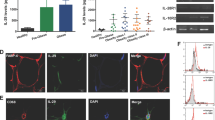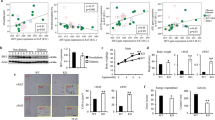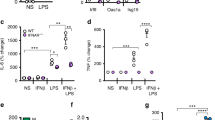Abstract
Background:
Inflammatory factors derived from adipose tissue have been implicated in mediating insulin resistance in obesity. We sought to identify these using explanted human adipose tissue exposed to innate and adaptive immune stimuli.
Methods:
Subcutaneous and omental adipose tissue from obese, insulin-resistant donors was cultured in the presence of macrophage and T-cell stimuli, and the conditioned medium tested for its ability to inhibit insulin-stimulated glucose uptake into human Simpson–Golabi–Behmel Syndrome (SGBS) adipocytes. The nature of the inhibitory factor in conditioned medium was characterized physicochemically, inferred by gene microarray analysis and confirmed by antibody neutralization.
Results:
Conditioned medium from omental adipose tissue exposed to a combination of macrophage- and T-cell stimuli inhibited insulin action and adiponectin secretion in SGBS adipocytes. This effect was associated with a pronounced change in adipocyte morphology, characterized by a decreased number of lipid droplets of increased size. The bioactivity of conditioned medium was abolished by trypsin treatment and had a molecular weight of 46 kDa by gel filtration. SGBS adipocytes exposed to a bioactive medium expressed multiple gene transcripts regulated by interferon-gamma (IFN-γ). Recombinant human IFN-γ recapitulated the effects of the bioactive medium and neutralizing antibody against IFN-γ but not other candidate factors abrogated medium bioactivity.
Conclusions:
IFN-γ released from inflamed omental adipose tissue may contribute to the metabolic abnormalities seen in human obesity.
This is a preview of subscription content, access via your institution
Access options
Subscribe to this journal
Receive 12 print issues and online access
$259.00 per year
only $21.58 per issue
Buy this article
- Purchase on Springer Link
- Instant access to full article PDF
Prices may be subject to local taxes which are calculated during checkout





Similar content being viewed by others
References
Wentworth JM, Naselli G, Brown WA, Doyle L, Phipson B, Smyth GK et al. Pro-inflammatory CD11c+CD206+ adipose tissue macrophages are associated with insulin resistance in human obesity. Diabetes 2010; 59: 1648–1656.
Zeyda M, Gollinger K, Kriehuber E, Kiefer FW, Neuhofer A, Stulnig TM . Newly identified adipose tissue macrophage populations in obesity with distinct chemokine and chemokine receptor expression. Int J Obes 2010; 34: 1684–1694.
Weisberg SP, McCann D, Desai M, Rosenbaum M, Leibel RL, Ferrante AW Jr . Obesity is associated with macrophage accumulation in adipose tissue. J Clin Invest 2003; 112: 1796–1808.
Xu H, Barnes GT, Yang Q, Tan G, Yang D, Chou CJ et al. Chronic inflammation in fat plays a crucial role in the development of obesity-related insulin resistance. J Clin Invest 2003; 112: 1821–1830.
Cancello R, Tordjman J, Poitou C, Guilhem G, Bouillot JL, Hugol D et al. Increased infiltration of macrophages in omental adipose tissue is associated with marked hepatic lesions in morbid human obesity. Diabetes 2006; 55: 1554–1561.
Kloting N, Fasshauer M, Dietrich A, Kovacs P, Schon MR, Kern M et al. Insulin-sensitive obesity. Am J Physiol Endocrinol Metab 2010; 299: E506–E515.
Osborn O, Olefsky JM . The cellular and signaling networks linking the immune system and metabolism in disease. Nat Med 2012; 18: 363–374.
Mathis D . Immunological goings-on in visceral adipose tissue. Cell Metab 2013; 17: 851–859.
Hotamisligil GS, Shargill NS, Spiegelman BM . Adipose expression of tumor necrosis factor-alpha: direct role in obesity-linked insulin resistance. Science 1993; 259: 87–91.
Chavey C, Lazennec G, Lagarrigue S, Clape C, Iankova I, Teyssier J et al. CXC ligand 5 is an adipose-tissue derived factor that links obesity to insulin resistance. Cell Metab 2009; 9: 339–349.
Wascher TC, Lindeman JH, Sourij H, Kooistra T, Pacini G, Roden M . Chronic TNF-alpha neutralization does not improve insulin resistance or endothelial function in 'healthy' men with metabolic syndrome. Mol Med 2011; 17: 189–193.
van Asseldonk EJ, Stienstra R, Koenen TB, Joosten LA, Netea MG, Tack CJ . Treatment with Anakinra improves disposition index but not insulin sensitivity in nondiabetic subjects with the metabolic syndrome: a randomized, double-blind, placebo-controlled study. J Clin Endocrinol Metab 2011; 96: 2119–2126.
Mestas J, Hughes CC . Of mice and not men: differences between mouse and human immunology. J Immunol 2004; 172: 2731–2738.
Wabitsch M, Brenner RE, Melzner I, Braun M, Moller P, Heinze E et al. Characterization of a human preadipocyte cell strain with high capacity for adipose differentiation. Int J Obes Relat Metab Disord 2001; 25: 8–15.
Gurnell M, Wentworth JM, Agostini M, Adams M, Collingwood TN, Provenzano C et al. A dominant-negative peroxisome proliferator-activated receptor gamma (PPARgamma) mutant is a constitutive repressor and inhibits PPARgamma-mediated adipogenesis. J Biol Chem 2000; 275: 5754–5759.
Deng T, Lyon CJ, Minze LJ, Lin J, Zou J, Liu JZ et al. Class II major histocompatibility complex plays an essential role in obesity-induced adipose inflammation. Cell Metab 2013; 17: 411–422.
Ritchie ME, Phipson B, Wu D, Hu Y, Law CW, Shi W et al. limma powers differential expression analyses for RNA-sequencing and microarray studies. Nucleic Acids Res 2015; 43: e47.
Silver JD, Ritchie ME, Smyth GK . Microarray background correction: maximum likelihood estimation for the normal-exponential convolution. Biostatistics 2009; 10: 352–363.
Phipson B, Lee S, Majewski IJ, Alexander WS, Smyth GK . Robust hyperparameter estimation protects against hypervariable genes and improves power to detect differential expression. Ann Appl Stat 2016; 10: 946–963.
Shi W, Oshlack A, Smyth GK . Optimizing the noise versus bias trade-off for Illumina whole genome expression BeadChips. Nucleic Acids Res 2010; 38: e204.
Smyth GK, Michaud J, Scott HS . Use of within-array replicate spots for assessing differential expression in microarray experiments. Bioinformatics 2005; 21: 2067–2075.
Wu D, Lim E, Vaillant F, Asselin-Labat ML, Visvader JE, Smyth GK . ROAST: rotation gene set tests for complex microarray experiments. Bioinformatics 2010; 26: 2176–2182.
Wu D, Smyth GK . Camera: a competitive gene set test accounting for inter-gene correlation. Nucleic Acids Res 2012; 40: e133.
Liberzon A, Subramanian A, Pinchback R, Thorvaldsdottir H, Tamayo P, Mesirov JP . Molecular signatures database (MSigDB) 3.0. Bioinformatics 2011; 27: 1739–1740.
Tiller G, Laumen H, Fischer-Posovszky P, Finck A, Skurk T, Keuper M et al. LIGHT (TNFSF14) inhibits adipose differentiation without affecting adipocyte metabolism. Int J Obes 2011; 35: 208–216.
Boehm U, Klamp T, Groot M, Howard JC . Cellular responses to interferon-gamma. Annu Rev Immunol 1997; 15: 749–795.
Esser N, L'Homme L, De Roover A, Kohnen L, Scheen AJ, Moutschen M et al. Obesity phenotype is related to NLRP3 inflammasome activity and immunological profile of visceral adipose tissue. Diabetologia 2013; 56: 2487–2497.
Hajri T, Tao H, Wattacheril J, Marks-Shulman P, Abumrad NN . Regulation of adiponectin production by insulin: interactions with tumor necrosis factor-alpha and interleukin-6. Am J Physiol Endocrinol Metab 2011; 300: E350–E360.
Stolic M, Russell A, Hutley L, Fielding G, Hay J, MacDonald G et al. Glucose uptake and insulin action in human adipose tissue–influence of BMI, anatomical depot and body fat distribution. Int J Obes Relat Metab Disord 2002; 26: 17–23.
De Maeyer E, De Maeyer-Guignard J . Interferon-gamma. Curr Opin Immunol 1992; 4: 321–326.
Yip YK, Pang RH, Urban C, Vilcek J . Partial purification and characterization of human gamma (immune) interferon. Proc Natl Acad Sci USA 1981; 78: 1601–1605.
Baccala R, Kono DH, Theofilopoulos AN . Interferons as pathogenic effectors in autoimmunity. Immunol Rev 2005; 204: 9–26.
Feuerer M, Herrero L, Cipolletta D, Naaz A, Wong J, Nayer A et al. Lean, but not obese, fat is enriched for a unique population of regulatory T cells that affect metabolic parameters. Nat Med 2009; 15: 930–939.
Wali JA, Thomas HE, Sutherland AP . Linking obesity with type 2 diabetes: the role of T-bet. Diabetes Metab Syndrome Obes 2014; 7: 331–340.
Khazen W, Distel E, Collinet M, Chaves VE, M'Bika JP, Chany C et al. Acute and selective inhibition of adipocyte glyceroneogenesis and cytosolic phosphoenolpyruvate carboxykinase by interferon gamma. Endocrinology 2007; 148: 4007–4014.
McGillicuddy FC, Chiquoine EH, Hinkle CC, Kim RJ, Shah R, Roche HM et al. Interferon gamma attenuates insulin signaling, lipid storage, and differentiation in human adipocytes via activation of the JAK/STAT pathway. J Biol Chem 2009; 284: 31936–31944.
Keay S, Grossberg SE . Interferon inhibits the conversion of 3T3-L1 mouse fibroblasts into adipocytes. Proc Natl Acad Sci USA 1980; 77: 4099–4103.
Wada T, Hoshino M, Kimura Y, Ojima M, Nakano T, Koya D et al. Both type I and II IFN induce insulin resistance by inducing different isoforms of SOCS expression in 3T3-L1 adipocytes. Am J Physiol Endocrinol Metab 2011; 300: E1112–E1123.
Simons PJ, van den Pangaart PS, Aerts JM, Boon L . Pro-inflammatory delipidizing cytokines reduce adiponectin secretion from human adipocytes without affecting adiponectin oligomerization. J Endocrinol 2007; 192: 289–299.
O'Rourke RW, White AE, Metcalf MD, Winters BR, Diggs BS, Zhu X et al. Systemic inflammation and insulin sensitivity in obese IFN-gamma knockout mice. Metabolism 2012; 61: 1152–1161.
Rocha VZ, Folco EJ, Sukhova G, Shimizu K, Gotsman I, Vernon AH et al. Interferon-gamma, a Th1 cytokine, regulates fat inflammation: a role for adaptive immunity in obesity. Circ Res 2008; 103: 467–476.
Wong N, Fam BC, Cempako GR, Steinberg GR, Walder K, Kay TW et al. Deficiency in interferon-gamma results in reduced body weight and better glucose tolerance in mice. Endocrinology 2011; 152: 3690–3699.
Stolarczyk E, Vong CT, Perucha E, Jackson I, Cawthorne MA, Wargent ET et al. Improved insulin sensitivity despite increased visceral adiposity in mice deficient for the immune cell transcription factor T-bet. Cell Metab 2013; 17: 520–533.
Priceman SJ, Kujawski M, Shen S, Cherryholmes GA, Lee H, Zhang C et al. Regulation of adipose tissue T cell subsets by Stat3 is crucial for diet-induced obesity and insulin resistance. Proc Natl Acad Sci USA 2013; 110: 13079–13084.
Faber DR, Moll FL, Vink A, van der Waal C, Kalkhoven E, Schipper HS et al. Adipose tissue quantity and composition contribute to adipokine concentrations in the subclavian vein and the inferior mesenteric vein. Int J Obes 2012; 36: 1078–1085.
Glass CK, Olefsky JM . Inflammation and lipid signaling in the etiology of insulin resistance. Cell Metab 2012; 15: 635–645.
Turer AT, Scherer PE . Adiponectin: mechanistic insights and clinical implications. Diabetologia 2012; 55: 2319–2326.
Faber DR, van der Graaf Y, Westerink J, Kanhai DA, Monajemi H, Visseren FL et al. Hepatocyte growth factor and interferon-gamma inducible protein-10 are related to visceral adiposity. Eur J Clin Invest 2013; 43: 369–378.
Zhang X, Shen J, Man K, Chu ES, Yau TO, Sung JC et al. CXCL10 plays a key role as an inflammatory mediator and a non-invasive biomarker of non-alcoholic steatohepatitis. J Hepatol 2014; 61: 1365–1375.
Nishimura S, Manabe I, Nagasaki M, Eto K, Yamashita H, Ohsugi M et al. CD8+ effector T cells contribute to macrophage recruitment and adipose tissue inflammation in obesity. Nat Med 2009; 15: 914–920.
Acknowledgements
We are grateful to the trial participants. This work was supported by the Australian National Health and Medical Research Council (Program Grant 1037321 and Fellowship 1080887 to LCH, Program Grant 1016647 to JGZ, Program Grant 1054618 and Fellowship 1058892 to GKS and CRE 1078106 Fellowship to JMW). This work was made possible through Victorian State Government Operational Infrastructure Support and Australian National Health and Medical Research Council Research Institute Infrastructure Support Scheme.
Author contributions
JMW takes full responsibility for the work as a whole, including the study design, access to data and the decision to submit and publish the manuscript. JMW and LCH designed the study, analyzed the data and prepared the manuscript. JMW performed most experiments, with contributions from JGZ, EB and GN. CL, MR and GS analyzed the microarray data. PEO recruited participants and obtained tissue samples. All authors edited the manuscript.
Author information
Authors and Affiliations
Corresponding author
Ethics declarations
Competing interests
The authors declare no conflict of interest.
Additional information
Supplementary Information accompanies this paper on International Journal of Obesity website
Supplementary information
Rights and permissions
About this article
Cite this article
Wentworth, J., Zhang, JG., Bandala-Sanchez, E. et al. Interferon-gamma released from omental adipose tissue of insulin-resistant humans alters adipocyte phenotype and impairs response to insulin and adiponectin release. Int J Obes 41, 1782–1789 (2017). https://doi.org/10.1038/ijo.2017.180
Received:
Revised:
Accepted:
Published:
Issue Date:
DOI: https://doi.org/10.1038/ijo.2017.180
This article is cited by
-
Adipocyte-specific deletion of PIP5K1c reduces diet-induced obesity and insulin resistance by increasing energy expenditure
Lipids in Health and Disease (2022)
-
20 Years with SGBS cells - a versatile in vitro model of human adipocyte biology
International Journal of Obesity (2022)
-
IFNγ-producing NK cells in adipose tissue are associated with hyperglycemia and insulin resistance in obese women
International Journal of Obesity (2021)
-
Interferon-alpha 2 but not Interferon-gamma serum levels are associated with intramuscular fat in obese patients with nonalcoholic fatty liver disease
Journal of Translational Medicine (2019)



